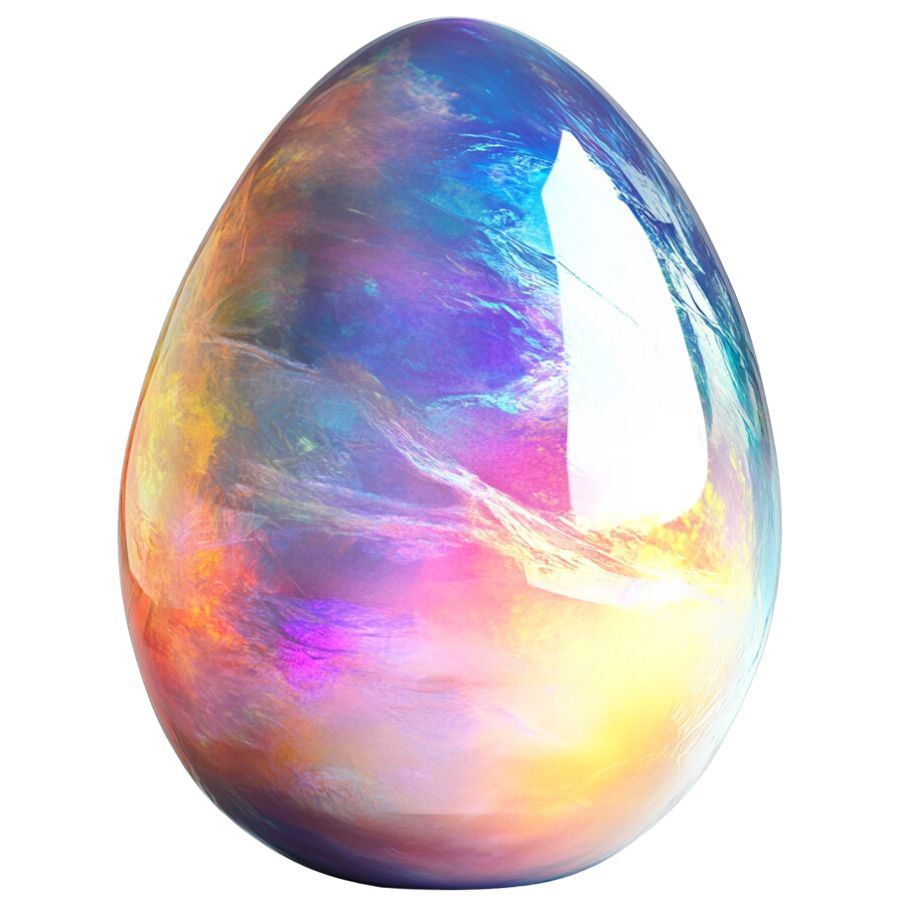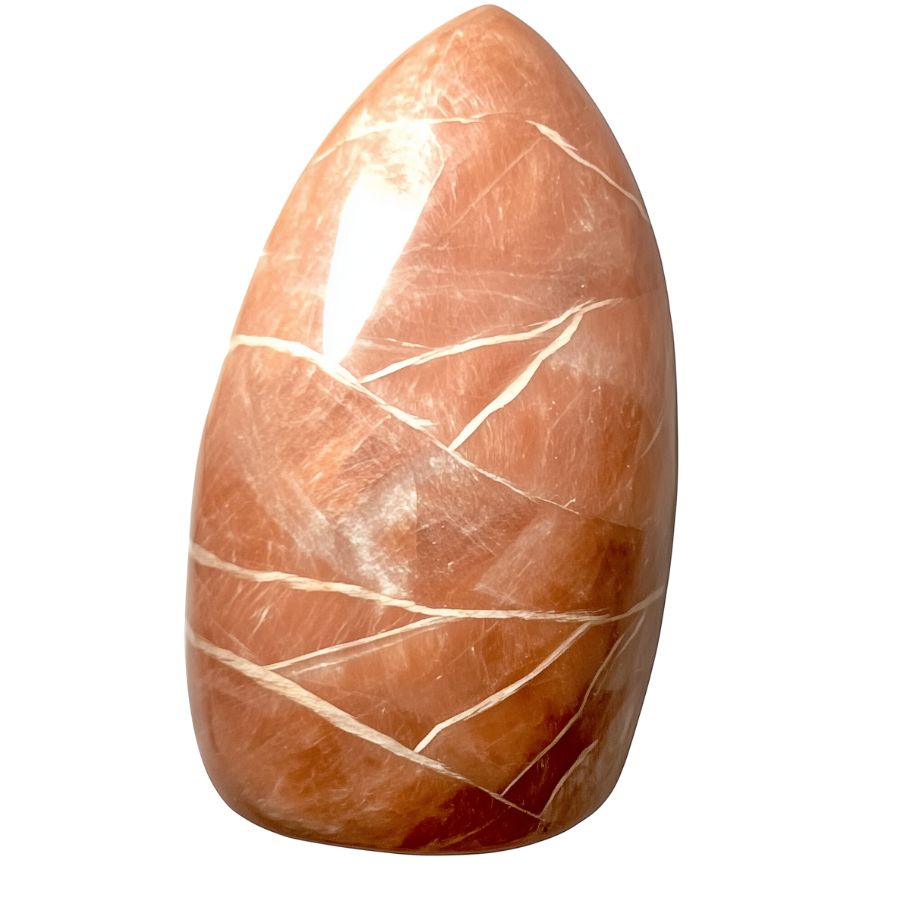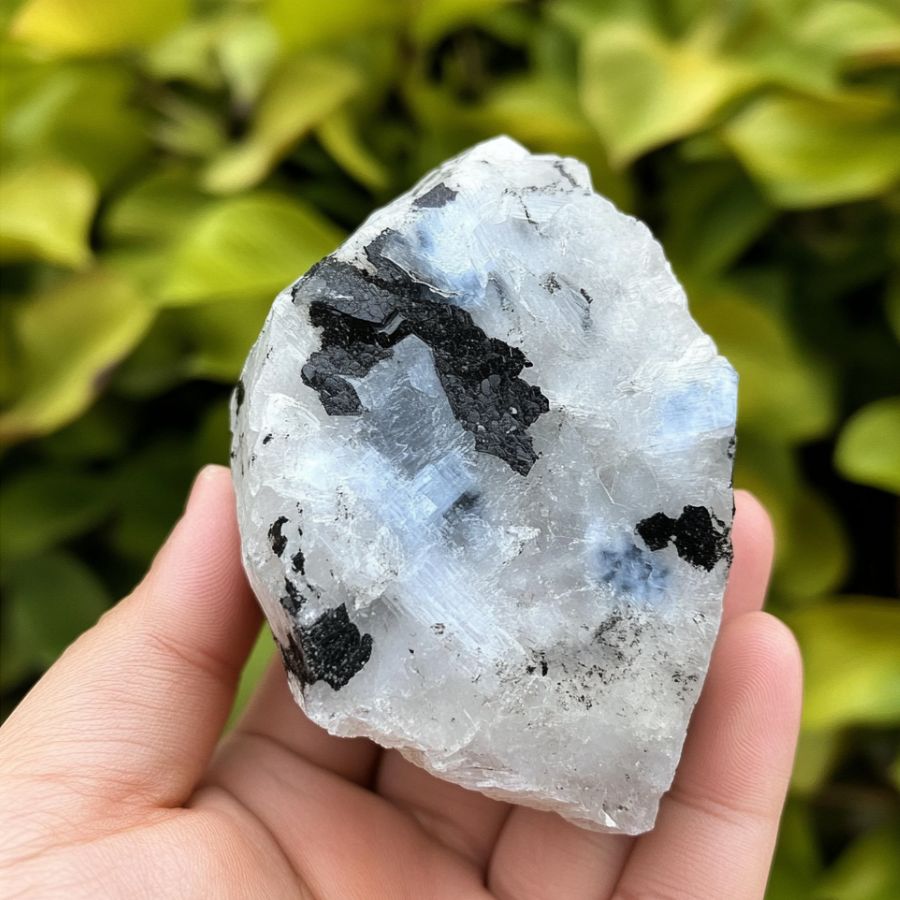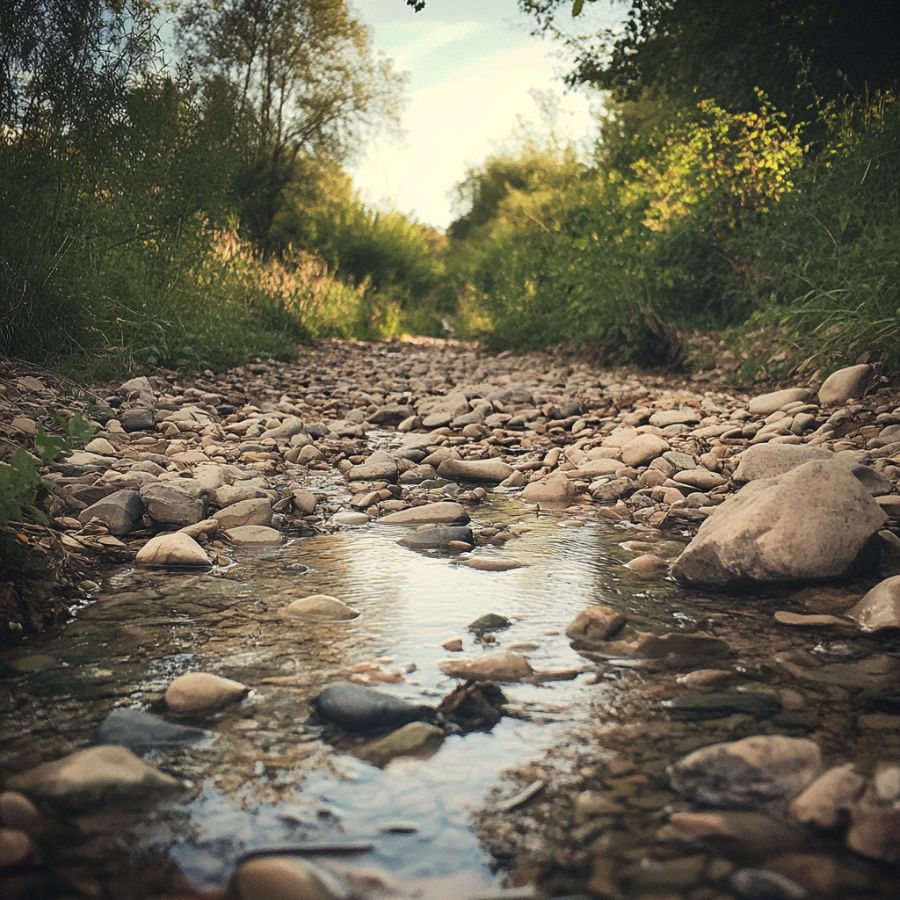From the Atlantic Ocean to Pennsylvania, from Connecticut to Canada, New York offers diverse landscapes for gem enthusiasts.
Searching aimlessly for moonstones in such a big state can be exhausting. We understand your frustration. That’s why we’ve compiled this list of the 8 best places to find moonstones in New York.
Our carefully researched guide will save you precious time and effort. No more guessing or disappointment.
With insider knowledge of promising public lands throughout New York, we’ll lead you to prime moonstone territory.
How Moonstone Forms Here

Moonstone starts as feldspar, a mineral made of aluminum and silicate. As the rocks cool slowly, two types of feldspar—orthoclase and albite—separate into thin layers. As the layers solidify, they create the stone’s unique internal structure.
The stone’s color, usually milky white with a blue or peach glow, depends on the thickness of these layers and how they catch the light.
When light enters the stone, it scatters between these layers, producing a moonstone’s signature shimmering glow called adularescence. This optical effect makes it appear as if light is floating beneath the surface.
Over millions of years, plate tectonics push the moonstone deposits closer to the surface where they can be mined. The rarity and specific geology needed to create moonstones add to their mystique as one of the world’s most magical gemstones.
The Types Of Moonstone
Our state is a treasure trove of stunning moonstone varieties. These natural wonders come in various forms, each with its own unique charm and allure:
Blue Moonstone

Blue Moonstone is known for its transparent to translucent body with a floating blue sheen on the surface. This sheen, called adularescence, is caused by light reflecting off layers of minerals within the stone.
The most prized Blue Moonstones have a strong blue color and perfect clarity. This makes them stand out from other types, which might be colorless or milky.
What’s special about Blue Moonstone is its ethereal glow. The adularescence creates a soft, shimmering light beneath its surface. This unique optical effect, combined with its rarity, makes it popular among collectors and jewelry enthusiasts.
Rainbow Moonstone

Rainbow Moonstone is famous for its labradorescence, a colorful sheen that shows a spectrum of colors like blue, yellow, orange, and purple. This effect is especially striking against its white body color, giving it a radiant appearance.
Unlike traditional moonstones, Rainbow Moonstones’ play of colors is more vivid and varied. It’s often confused with labradorite but can be distinguished by its pearly sheen and more transparent body.
Some Rainbow Moonstones contain inclusions of black tourmaline, visible in untreated stones. This gemstone gained popularity during the Art Nouveau period and continues to be favored in modern jewelry for its unique optical effects.
Pink Moonstone

Pink Moonstone shows a delicate pink or peach hue, ranging from honey to beige. Its color is soft and subtle, setting it apart from other moonstones with more vibrant shades.
This stone has a pearly or vitreous luster and is generally translucent. High-quality Pink Moonstones often display a white sheen on the surface. Some specimens can even show a cat’s eye or star effect due to their unique internal structure.
Pink Moonstone is one of the rarest varieties of moonstone. Its delicate color and unique optical effects make it highly sought after. Unlike Pink Opal, which is more opaque, Pink Moonstone is characterized by its iridescent sheen.
Star Moonstone

Star Moonstone shows a unique optical effect called asterism, creating a four-pointed star pattern on its surface. This happens because of needle-like inclusions in the stone that reflect light in a special way.
These moonstones are usually translucent to opaque, with colors ranging from colorless to shades of blue, gray, or white. The star effect is best seen when the stone is cut into a cabochon shape.
Star Moonstone is rarer than other types, making it highly desirable. The strongest and most well-defined stars are often found in specimens from Sri Lanka.
Peach Moonstone

Peach Moonstone stands out with its soft peach or orange hue, ranging from pale to more intense shades. It has a shimmering effect called adularescence, which creates a glowing appearance under certain light.
Unlike other moonstones, Peach Moonstone’s glow is more subdued and warm-toned. It’s generally translucent to semi-transparent, allowing light to pass through and enhance its beauty.
What’s special about Peach Moonstone is its rarity. This scarcity makes it desirable among collectors and jewelry makers.
Its warm tones are particularly favored in designs aiming for a soft, romantic look. The unique color and rarity of Peach Moonstone set it apart in the world of gemstones.
Brown Moonstone

Brown Moonstone has a warm, earthy color that ranges from light honey to deep chocolate brown. It’s translucent to opaque and shows the typical moonstone glow, caused by light scattering between layers of different minerals inside the stone.
What makes Brown Moonstone unique is its rarity compared to other colors like white, gray, and rainbow. The brown color comes from iron impurities in the stone.
Brown Moonstone doesn’t show a strong play of color or iridescence like other moonstones. Its subtle beauty lies in its rich, earthy tones and soft glow. This makes it a distinctive choice for those who appreciate understated elegance in their stones.
Cat’s Eye Moonstone

Cat’s Eye Moonstone is known for its striking appearance. It has a translucent body with a narrow band of light that moves across the surface, looking like a cat’s eye. This effect, called chatoyancy, is caused by tiny needle-like inclusions in the stone.
What sets it apart from other moonstones is this cat’s eye effect. While other moonstones might have a blue sheen, Cat’s Eye Moonstone is all about this moving line of light.
The chatoyancy in Cat’s Eye Moonstone is highly sought after. It’s more valuable than standard moonstones because of how rare it is to find high-quality pieces with strong chatoyancy. This unique look makes it a favorite among collectors and stone enthusiasts.
Green Moonstone

Green moonstone captivates with its soft, pastel green hue and subtle white sheen. Unlike other moonstones, it often displays a velvety texture that’s pleasing to both eye and touch.
Each green moonstone is unique, with color variations ranging from faint green streaks to more pronounced green hues within a milky white base. This diversity means no two stones look exactly alike.
The stone’s green color comes from its high nickel content, making it a rarer find in the moonstone family. This unique composition sets it apart and makes it a favorite among collectors who appreciate its distinctive appearance.
What Rough Moonstone Looks Like
It’s important to understand what a rough moonstone looks like to know what you’re looking for. Here are a few things to keep an eye for:
Check for a Glassy or Waxy Luster

Look for a shiny surface. Moonstone usually has a glassy or waxy luster. It might not sparkle like a diamond, but it has a soft glow.
Hold it up to the light and see if it catches a gentle sheen. If you spot that smooth, silky look, you might have found one.
DON'T MISS OUT ON ANY GREAT FINDS!
While you're out searching for Moonstone you're going to find a lot of other interesting rocks and minerals along the way. The last thing you want to do is toss out something really interesting or valuable. It can be easy to misidentify things without a little guidance.
We've put together a fantastic field guide that makes identifying 140 of the most interesting and valuable rocks and minerals you will find REALLY EASY. It's simple to use, really durable, and will allow you to identify just about any rock and mineral you come across. Make sure you bring it along on your hunt!
Assess the Density and Weight

Moonstone feels relatively light for a gemstone. If you pick it up and it feels heavier than expected, it might not be moonstone.
The specific gravity ranges from 2.54 to 2.66, so it should feel somewhat light in your hand.
Notice the Blue or White Sheen

Tilt the stone in your hand. If you notice a blue or white sheen, that’s a good sign. Moonstone has something called adularescence. This is when light reflects inside the stone, creating a soft glow.
It’s one of the key features of moonstone, so keep an eye out for that flash of color.
Look for Rounded Edges

Notice the edges. Moonstone tends to have rounded edges, not sharp ones. This is due to the way it forms in nature.
The rounded shape makes it easier to spot when you’re searching. Keep an eye out for stones with soft, curved edges.
A Quick Request About Collecting
Always Confirm Access and Collection Rules!
Before heading out to any of the locations on our list you need to confirm access requirements and collection rules for both public and private locations directly with the location. We haven’t personally verified every location and the access requirements and collection rules often change without notice.
Many of the locations we mention will not allow collecting but are still great places for those who love to find beautiful rocks and minerals in the wild without keeping them. We also can’t guarantee you will find anything in these locations since they are constantly changing.
Always get updated information directly from the source ahead of time to ensure responsible rockhounding. If you want even more current options it’s always a good idea to contact local rock and mineral clubs and groups
Tips on Where to Look
When you reach the places we’ve listed below, keep these things in mind while searching:
Riverbeds and Streams

Check out riverbeds and streams. Moonstones can often be found in these areas.
They wash down from the mountains and settle in the gravel. Search along the edges, especially after heavy rain. It’s an easy way to start.
Sandy Beaches

Head to sandy beaches. Look where the sand meets rocks or pebbles. The constant movement of the water helps uncover hidden treasures.
You might find moonstones mixed in with other small stones. The search here can be fun and rewarding.
Old Quarries

Visit old quarries. These places often have piles of loose rocks and gravel where moonstones might be hiding.
The digging and blasting might have already brought them to the surface. Just a little effort and you might find something cool.
Sedimentary Rocks

Check sedimentary rock areas. Moonstones form in these rocks, so they’re likely to be around.
Look for outcroppings or places where the rocks have broken apart. The stones might be easier to spot after some weathering.
Some Great Places To Start
New York offers several prime locations for searching for moonstones. These areas are known for their geological diversity, which includes various minerals suitable for gem collection.
Always Confirm Access and Collection Rules!
Before heading out to any of the locations on our list you need to confirm access requirements and collection rules for both public and private locations directly with the location. We haven’t personally verified every location and the access requirements and collection rules often change without notice.
Many of the locations we mention will not allow collecting but are still great places for those who love to find beautiful rocks and minerals in the wild without keeping them. We also can’t guarantee you will find anything in these locations since they are constantly changing.
Always get updated information directly from the source ahead of time to ensure responsible rockhounding. If you want even more current options it’s always a good idea to contact local rock and mineral clubs and groups
Saranac Lake

Saranac Lake is a village named after the nearby Upper, Middle, and Lower Saranac Lakes. It is located within the Adirondack Mountains, northern part of New York State.
Saranac Lake spans parts of Franklin and Essex counties and is situated about 9 miles west of Lake Placid. Moonstone has been found here, along with other popular stones like garnet and labradorite.
The region’s geological history, featuring high-grade metamorphic rocks, makes it an excellent spot for rockhounding.
In Saranac Lake, you can search for Moonstone in areas with exposed bedrock, such as road cuts and outcrops. Additionally, gravels and creeks in the region may also yield moonstone specimens, especially in areas where pegmatites are present.
The McKenzie Pond Boulder Trail features large boulders that may hide interesting minerals. This combination of natural beauty and rich geology makes Saranac Lake an exciting destination for gemstone enthusiasts looking for moonstones and more.
Rockdale Road Quarry

Rockdale Road Quarry in Saratoga County is located in the northeastern part of New York. This active quarry, known for its rich mineral deposits, offers a unique opportunity to find moonstone.
The site’s geological history dates back millions of years, creating ideal conditions for the formation of various minerals.
Moonstone hunters can explore the quarry’s gravel piles, where these lustrous gems often hide. The creeks running through the area are another hotspot, as water action can expose and transport these beautiful stones.
For a different perspective, check out the exposed rock faces along road cuts, where veins of minerals, including moonstone, might be visible.
What makes Rockdale Road Quarry special is its diverse mineral assemblage. Besides moonstone, you might stumble upon other interesting finds like garnet or quartz.
Newcomb Area

The Newcomb area along Lake Harris’s south shore is a hidden gem for moonstone hunters. The area’s unique geology, shaped by ancient metamorphic processes, creates an ideal environment for moonstone formation.
Rockhounds can explore the gravelly beaches and creek beds flowing into Lake Harris, where water erosion often exposes these gemstones. The nearby Goodnow Mountain, with its exposed rock faces, presents another good spot for enthusiasts.
While searching for moonstones, keep an eye out for other minerals like garnet and magnetite, which are also found in this mineral-rich region.
The area’s connection to the historic Adirondack Iron Works adds an extra layer of intrigue to your gemstone adventure.
Minerva Road

Minerva Road, located in Essex County’s Olmstedville area, is a winding mountain road that offers rockhounds gorgeous vistas and unique geological formations ripe for exploration.
The Olmstedville area is situated in the southwestern part of Essex County, with the town of Minerva encompassing a total area of approximately 160.3 square miles, of which 156.8 square miles is land and 3.5 square miles is water.
This scenic location, known for its stunning marble gorges and ancient potholes, offers a unique geological playground for rockhounds.
The area’s rich metamorphic rock formations, shaped over millions of years, create ideal conditions for moonstone formation.
Enthusiasts can explore the numerous pits along Minerva Road, where these ethereal gems often hide among the rocky terrain. The Adirondacks’ famous clear streams and eroded outcrops provide additional hunting grounds.
DeKalb Area

Nestled in the southwest corner of St. Lawrence County, the DeKalb area is a hidden gem for moonstone enthusiasts. This picturesque region, known for its old marble quarries, offers a unique rockhounding experience.
The area’s geological history dates back millions of years, resulting in the formation of high-quality marble and various minerals.
The old quarries, once bustling with mining activity, now serve as prime hunting grounds for moonstone seekers. These abandoned sites expose numerous mineral veins, making it easier to spot the ethereal glow of moonstones.
The stone’s presence here is linked to the area’s metamorphic rock formations, created under intense heat and pressure.
Places moonstone has been found by county
After discussing our top picks, we wanted to discuss the other places on our list. Below is a list of the additional locations where we have succeeded, along with a breakdown of each place by county.
| County | Location |
| Essex | 73 and Halhun Bushnel Rd in Keene Valley |
| St. Lawrence | Mitchell farm in Hermon Area |
| St. Lawrence | Richville area quarries |


